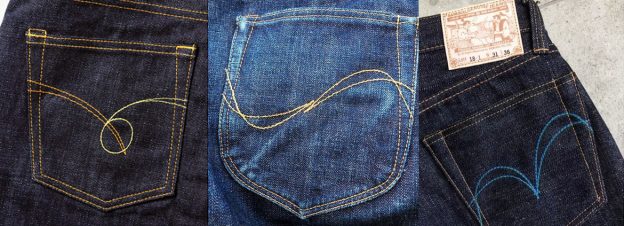When it comes to the most significant and noticeable details of jeans, embroidered arcuates (or arcs) on the pockets are one of the most recognizable elements. (Think the Big Mac sign, but for denim.)
When the American company Levi’s started using its famous embroidered arcs in the form of the « eagle beak » at the dawn of the denim industry, the goal was to make the product more recognizable and noticeable. As time passed, Japanese manufacturers created a whole variety of different options, which is why we’ve dedicated this post today to show you the big scope of these fabled arches.
As you may already know, Japanese jeans, in the form in which we now know them, were born from the desire to make the product as close to the classical American historical heritage. It so happened that the « copy » has significantly surpassed the « original », including in the details.
If you look at the arcs embroidered on the pockets of Japanese jeans, it will be noticeable that they are very close to the style of American jeans.
This was especially noticeable in an earlier period:
The old version of the of Sugar Cane 1947 arcs

The old version of The Flat Head arcs

The old version of Oni Denim arcs

Why do the Arcs of these jeans look different now? Plainly, they were forced to go a different way. In 2007, the American company Levi Strauss & Co. proposed a lawsuit in which claims were made for the use of parts that clearly imitate the products of this brand. Among the details of this suit were « moving objects in different directions » on the patch, a red tab on the back pocket, and of course, the arcs embroidered on the back pockets.
In the end, many Japanese manufacturers had to modify the design of their parts, including the arcs. The jeans did not take a drop, however, but came out on its own with its newfound identity and sulf-made brand, limiting the dependence on the images of the old American classics.
That being said, how is it with the arcs of Japanese jeans at the moment?
Momotaro
Some manufacturers do not use embroidered arcs at all, leaving pockets « clean ». This allows you to shift all attention to the denim itself, its unique character and texture.
For example, this is how the back pockets of the Momotaro Jeans line, are called the Vintage Label, look. The jeans of this series do not have any embroidered arcs, while the pocket has a white tab with a peach image and nothing else. A pocket like this is called a « blank canvas », which will change beautifully over time. A beautiful imprint of a purse, keychain or any other object will best be displayed on such a pocket. For example, the pockets of a well-worn Momotaro 0701 look like this:

Going To Battle Label of the same Momotaro Jeans looks much more noticeable. On the pocket of jeans with the help of silk-screen printing two parallel lines are drawn, which symbolize the legendary « combat flag of Momotaro« , with which the boy, according to legend, went into battle against the demons. The paint is very resistant and will still be there long after your fades have appeared. On the photo the model 0705SP is shown:

For the Copper Label series, the arcs are only embroidered on one pocket. This is clearly seen in the example of model G007, where a « half-arc » symbolizes a peach.

Japan Blue
“The younger brother » of Momotaro, Japan Blue was originally oriented not so much to the production of traditional classical jeans, but rather to a convenient modern product. These jeans are more focused on young people and people who love modern/fashionable silhouettes. The presence of classical elements of old American jeans are thus to a much lesser extent.
Japan Blue either does not use an embroidered arcs on the back pockets at all or uses such original arcs embroidered with two threads of different colors. Their form mimics the capital letters of this brand, JB. If on the jeans pocket of Japan Blue such arcs are used, then the name of the model contains the letter S (stitch). For example, JB0412S.

Oni Denim
In general, a manufacturer like Oni denim tries not to overload its jeans with details, focusing the owner’s attention on the material itself and its texture. However, Oni denim jeans use different versions of arcs.
The old version of arcs on the back pockets was like this, as already mentioned earlier

Nowadays several variants of pockets are used.
As of present, we find minimalistic « clean » pockets

Pockets with an ordinary embroidered arc from Oni Denim

A very peculiar variant, selvedge line is sewn on the pockets. Such an arc will be more prominent if there is a significant fading.

Samurai Jeans
Unlike Oni, a « monster » of the denim industry, Samurai Jeans likes to use a lot of details .. The arcs in the back pockets not being an exception. Samurai Jeans has quite a few options for arcs. For the Japanese market, traditional arcs are still available, reminiscent of the style and form of the classic heritage of American jeans.
For example, here are the arcs of the S5000VX model. It is embroidered with bright yellow threads and stands out against the background of jeans

Some models (for example, S710XX) use stitches on pockets made in the tone of indigo color, which will appear more clearly when the jeans are already thoroughly rubbed

The model S3000VX from Samurai was specially made in the style of the 40s. Arcs are painted by no accident- these were done on old jeans Levi’s, to maintain the recognition of jeans and at the same time observe the regime of strict savings. Of course Samurai Jeans repeats this detail not from a mockery/profit perspective, but as a sign of respect for the history of denim.

The Yamato series differ from Samurai by not only using a lighter denim, but also with fundamentally different details, uncharacteristic for heavy classic models. Here, a rounded shape of the back pockets is used, the arcs on which imitate the sign ~ on old Lee jeans.
For example, here is the arcs of the model S003JP:

Pherrow’s
Arcs on the pockets of Pherrow’s jeans on one side resemble the « levis » classics. These arcs are quite original – they imitate the head of a bison with horns and embroidered with threads of red color- its own interpretation of the western style.

Full Count
The company Full Count is one of the few that mostly continues to maintain the maximum amount of Levi’s produced parts. Here we can see both a very noticeable red and very recognizable arcs with minor changes.

By the way, if you want, you can make such arcs even more similar, just by removing a few threads below)

Studio D’Artisan
Before 2007, the arcs of the SDA jeans looked this way. Yes, it’s still the same recognizable classic based on the old Levi’s.

The modern modified arcs look more slanted to the side. In addition, to strengthen the design of pockets, the Studio D’Artisan jeans use an indigo cross stitch and a lining at the bottom of the pocket. This combination looks as if the jeans have already received a contrast fade, a very nice addition for denimheads.

In conclusion, having examined in detail various types of arcs from different Japanese manufacturers, we can say that now we see one side of adherence and continuity to the traditions of the past. On the other hand, at present, the distinctiveness and independence of Japanese brands are very clearly visible, making such a product more detailed and interesting with unique features 🙂

